Horizon Zero Dawn was a terrific game. Guess what? Its new expansion, The Frozen Wilds, is also good.
Developed by Killzone studio Guerrilla Games, it was an open-world action game about a young woman living in a mysterious, post-apocalyptic world where humans had broken into tribal factions and massive robotic beasts roamed free.
It was gorgeous and often exhilarating to play, a combination of The Witcher 3, Monster Hunter, Far Cry Primal and the new Tomb Raider. I found the game to be at its best when I was in the thick of it, squaring off against a towering metal monstrosity with only my wits and a bow to see me through.
Horizon also featured an unexpectedly well-done story, built on a fictional world that only got more interesting as it revealed itself. Thanks to some fine writing and voice acting, I took the time to listen to every audio log and read every text file I could find. I’ve played a bunch of great games in the months since I finished it, but Aloy’s story, and the story of those who came before her, has stuck with me.
[referenced url=”https://www.kotaku.com.au/2017/03/horizon-zero-dawn-the-kotaku-review/” thumb=”https://i.kinja-img.com/gawker-media/image/upload/t_ku-large/ctdzstr7vb1p97yhrhxj.png” title=”Horizon Zero Dawn: The Kotaku Review” excerpt=”For years now, the latest console generation has been coasting on the idea that more raw power means better games. The PS4’s newest exclusive, Horizon. Zero Dawn, is the rare game that delivers on that promise.”]
All of those positive attributes return in The Frozen Wilds, though trimmed down to fit into a standalone side-story. The expansion, which has been sewn seamlessly into the existing narrative, sends Aloy to explore a new far-north region of her world known as “The Cut”.
The Cut is populated by a hearty tribe of robot-worshippers known as The Banuk, who turned up from time to time in the rest of Zero Dawn but played a smaller role than the other tribes. Aloy arrives in The Cut to find the Banuk in crisis, a mysterious “Daemon” having conquered and corrupted the mountain-goddess they worship.
It’s wreaking havoc on their frozen valley, and they have no one to turn to for help. Enter Aloy.
[review image=”https://i.kinja-img.com/gawker-media/image/upload/gq6ttyvf0cmuszbladkx.png” heading=”Horizon Zero Dawn: The Frozen Wilds” label1=”BACK OF THE BOX QUOTE” description1=”Aren’t her hands cold?” label2=”TYPE OF GAME” description2=”Third-person robot hunting” label3=”LIKED” description3=”A well-acted story that fleshes out the world introduced in the main game. Combat remains fantastic; vistas remain gorgeous.” label4=”DISLIKED” description4=”Most new abilities and gear feel inessential. Audio logs and diary entries are well-written, but they’re still audio logs and diary entries.” label5=”DEVELOPER” description5=”Guerilla Games” label6=”PLATFORMS ” description6=”PS4 (Pro played)” label7=”RELEASE” description7=”Now” label8=”PLAYED” description8=”Completed the main story in around eight hours, spent another three or four hours doing sidequests and exploring.”]
The tale that follows, which took me around eight hours to complete, follows a similar template to that of the main game. Ever the outsider, Aloy visits with and gets to know the locals, trying her best to understand and respect their traditions even as she (and the player, most likely) is aware of just how ignorant they are about the true nature of their world.
She selflessly agrees to help anyone in need, venturing into a number of old-world utility installations and defunct bases, using her “focus” device to unlock doors and unearth secrets that the people around her can’t see or comprehend.
As in Zero Dawn, the story of the Banuk and the Daemon unfolds in parallel with the story of the long-dead people who lived in the region before the apocalyptic events in the main storyline. The Frozen Wilds‘ backstory lacks the emotional heft of the one from the main game, partly due to its smaller scope and partly because it doesn’t relate to Aloy as directly.
There are, however, still some affecting moments tucked away in audio logs and archived text communications, and it all ends with a denouement that ties more directly to the events of the main game. The epilogue even offers some welcome additional information regarding what the world was like before the fall.
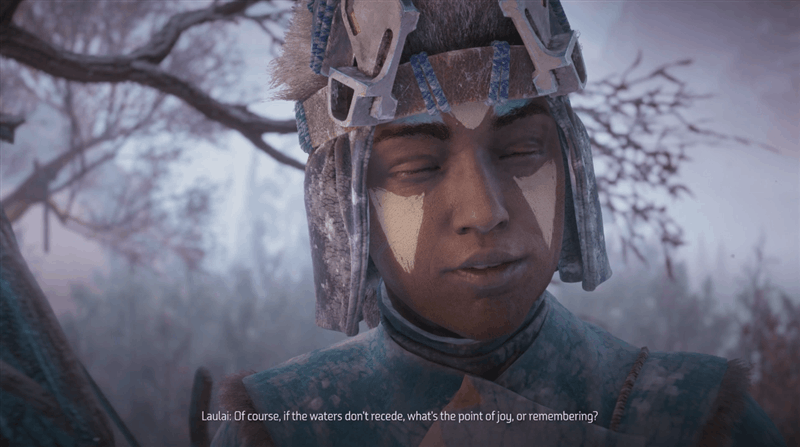
The present-timeline story of the Banuk is a bit rote on the whole, though plenty well-written and -acted. It’s helped along significantly by improve facial animations, both of which are a noticeable step up from the sometimes-waxy tete-a-tetes from the main game.
Some characters are a little too animated at times, but for the most part their body language and facial expressions convey as much as their spoken dialogue. The script is sturdy, as well, peppered with the same bits of plainspoken profundity that often turned up in the main game. “What a strange thing it is to be old,” muses one minor character. “To stare backward and see such distance, but to stare forward at a looming wall.”
Combat and exploration remain almost entirely unchanged from the base game, which is just fine with me. You’ll see many of the same robotic beasts in The Cut as in the rest of the game, albeit juiced up thanks to their new Daemon overlord.
There are also a couple of new enemy types, one of which is a massive, vicious bastard that features in a couple of outrageously hectic battles toward the end of the story.
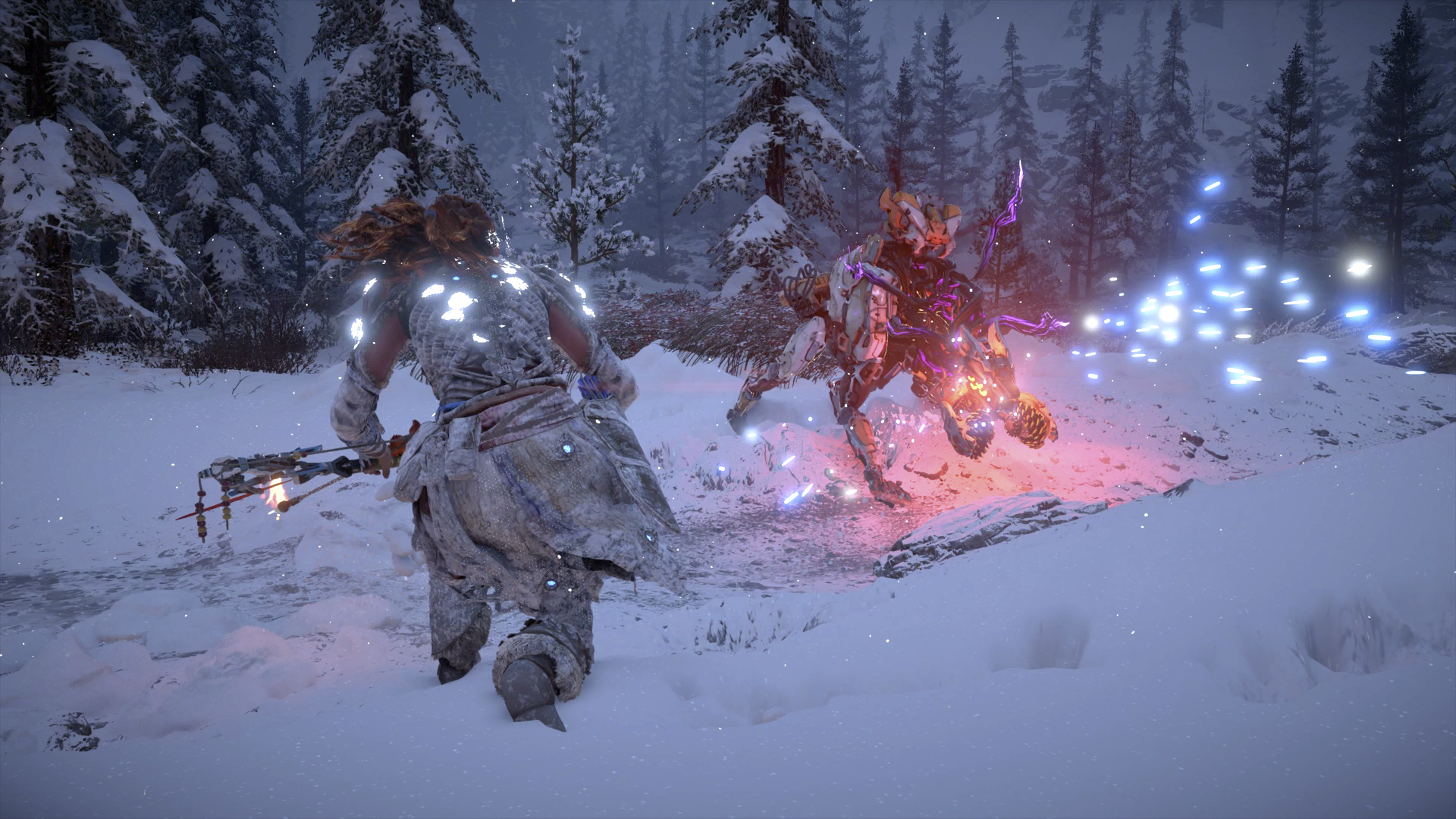
Every screenshot in this review was taken by me, in-game, with the included photo mode.
Returning to Horizon after several months away has given me a new appreciation for how much I like fighting robots in this game. A couple of the one-on-one showdowns in The Frozen Wilds rank among the most entertaining, sensorially overwhelming video game fights I’ve had in recent memory.
It remains a challenging game on normal difficulty, and I found myself thankful to be wearing the powerful shield armour I tracked down in the main game.
I played Zero Dawn obsessively back in February, upgrading every piece of gear and completing every sidequest. As a result, I went into The Frozen Wilds 15 levels above its suggested level 30 difficulty and still found myself surviving some climactic fights by the skin of my teeth.
Thanks to the roaring, crashing enemies and constant chaos of battle, it probably felt more challenging than it actually was. But when a game gets me laughing and yelling at my screen as much as this one does, I don’t really notice or even care about the distinction.
Most of those things could be said of the base game, of course. The Frozen Wilds introduces a few new ideas, though most feel inessential. The map is now dotted with robotic towers that emit pulses that heal robots, and disabling them requires straightforwardly sneaking up and hacking them before you begin fighting. Several missions involve joint-and-flow puzzles that change up the pacing a tad but which didn’t do much for me overall.
There’s a new skill tree with some unexciting new abilities that are either related to mounts (the robots you can ride around on) or give general quality-of-life improvements. I was most excited to unlock an ability that gave me 20% more storage space for crafting resources, which should give you a sense of how cool the new abilities are overall.
You can pick up some new gear including Banuk-themed armour, enhanced weapon mods, and more powerful versions of your standard bows, most of which you’ll have to buy using “Bluegleam,” a new currency that you get for completing quests in The Cut.
There are also a few new weapons that you get from story missions and which you can upgrade through a series of hunting quests. They’re neat enough, but none of them earned a spot in my regular loadout, which still consists of my three main bows and my trusty rope launcher.
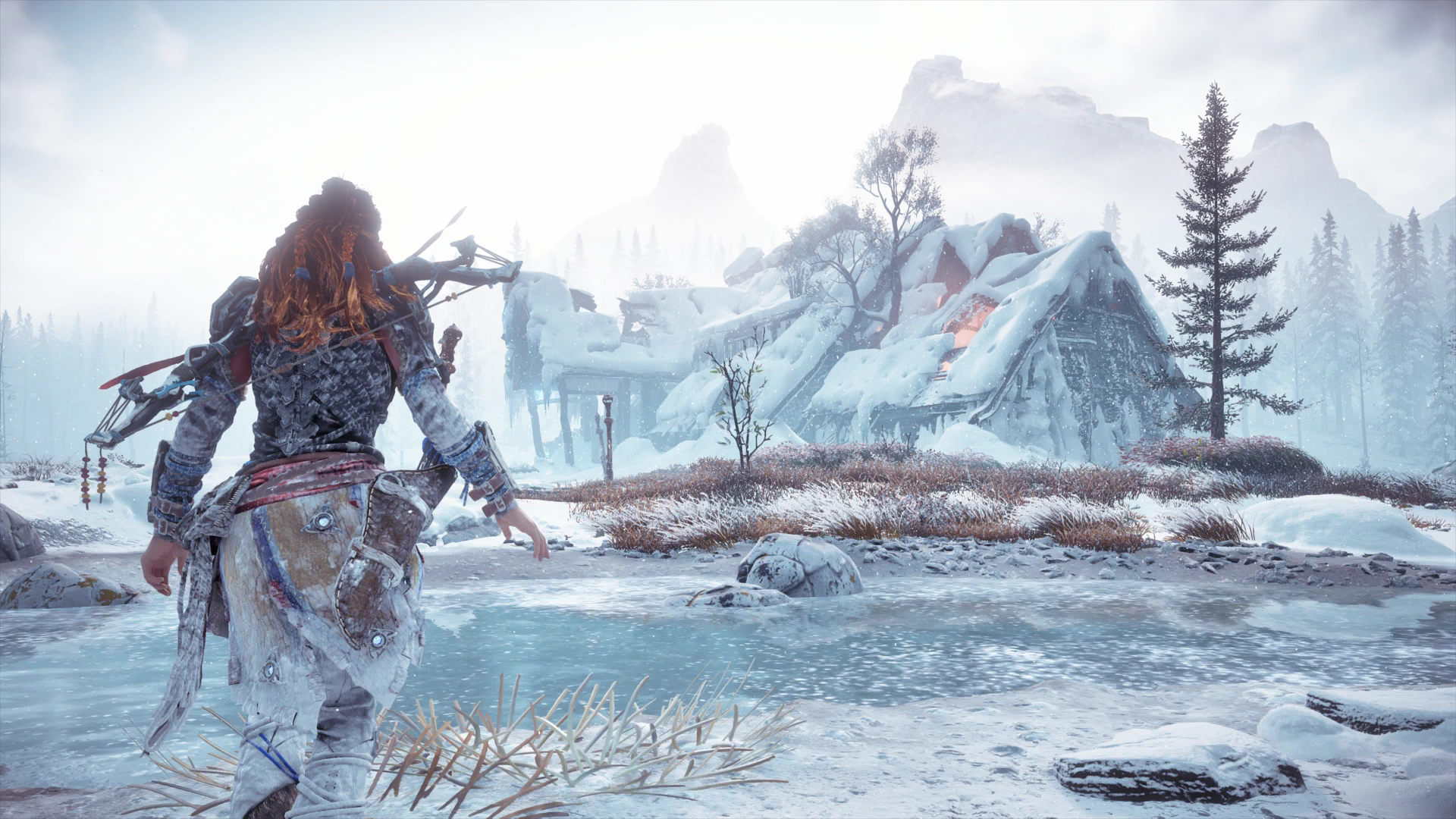
The Cut itself is a beautiful and daunting land of snowbanks, mountaintops, whipping winds, and thick white fog. Aloy is as present in her surroundings as ever, shivering as she stomps through snow, rubbing her arms for warmth as she offers her usual muttered commentary.
Horizon Zero Dawn remains one of the most visually striking games I’ve ever seen, though it’s an unsubtle beauty. Every visual dial has been cranked to the max, and every vista is jammed with shimmering snowflakes, blinding indigo and orange lights, and sunsets straight out of a Best Buy HDR demo reel.
It’s a lot, but it’s also so pretty. Every few minutes I was prompted to make use of the in-game photo mode, which Guerrilla has enhanced with new poses for Aloy.
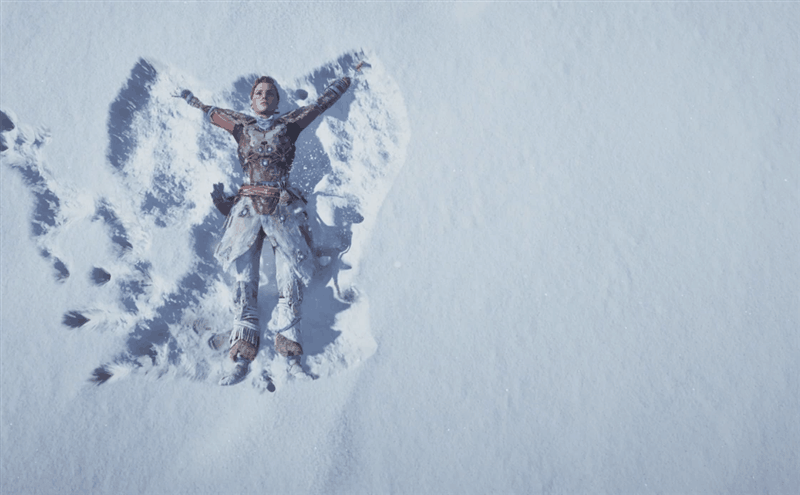
After the story’s conclusion, Aloy is free to continue exploring, mopping up remaining sidequests and taking on a few high-level monsters that were unleashed during the finale. I’d had my fill of chilly mountaintops by then, and found myself yearning to return to the arid deserts and thick rainforests of the southwestern parts of the map.
I plan to stick around The Cut nonetheless, if only to see what smaller secrets this snow-heaped neck of the woods might still have tucked away.
The Frozen Wilds doesn’t revolutionise or even significantly expand on the best ideas introduced in Zero Dawn. It succeeds in a more straightforward way: by giving us more of an already fantastic game.
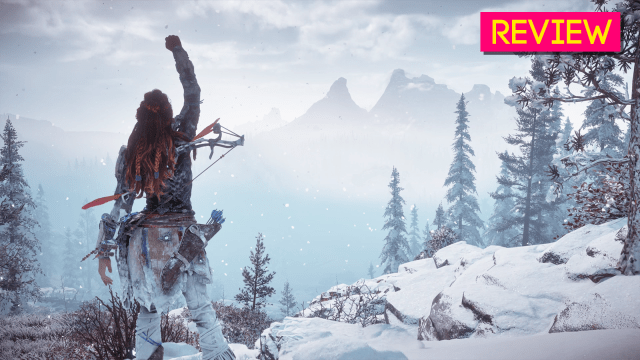
Comments
3 responses to “Horizon Zero Dawn: The Frozen Wilds: The Kotaku Review”
Other reviews I’ve read say similar, and basically repeat that its more of the same high quality game, but a few have pointed out that its short, and outside the main quest there aren’t all that many sidequests to keep you busy.
So if you’re the type of player that enjoys getting sidetracked and exploring the nooks and crannies, and digging into the side quests, just be aware that there may be limitations on those.
Horizon: Zero Dawn is my game of the year. For them to make more of the same game is all they ever need to do for me.
Except I want to be able to fly on the back of one of the bird robots. If that were to happen, the game would rise to a level esteem in my eyes that would likely not be rivalled in this generation.
Totally agree! H:ZD and its DLC are just great – definitely my GOTY.